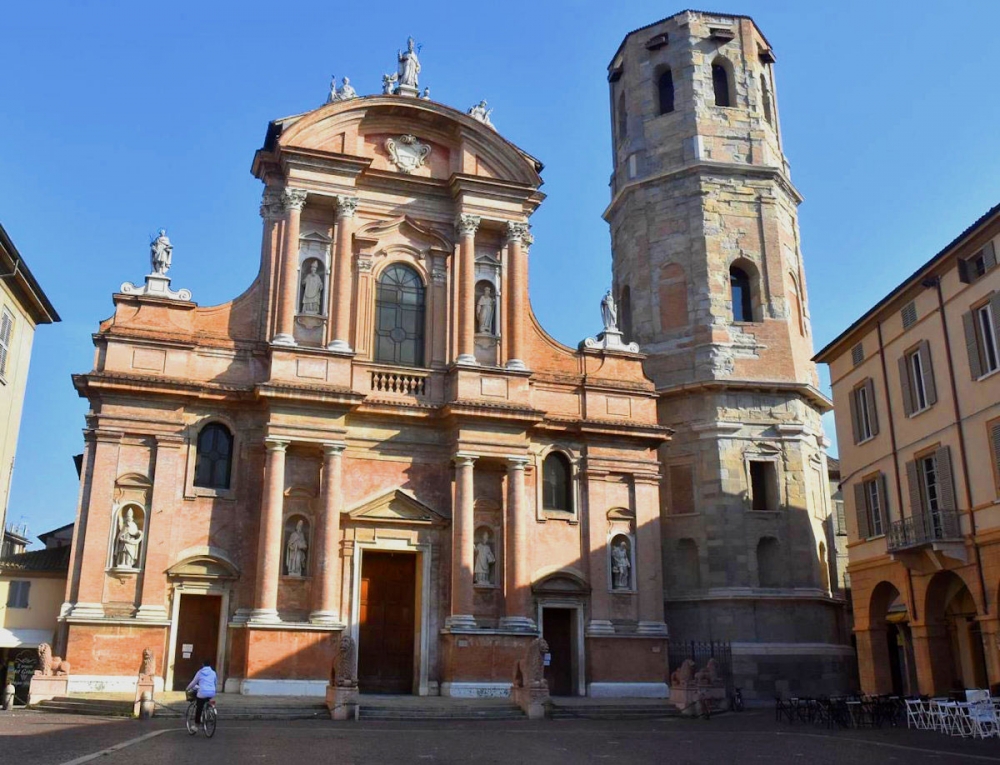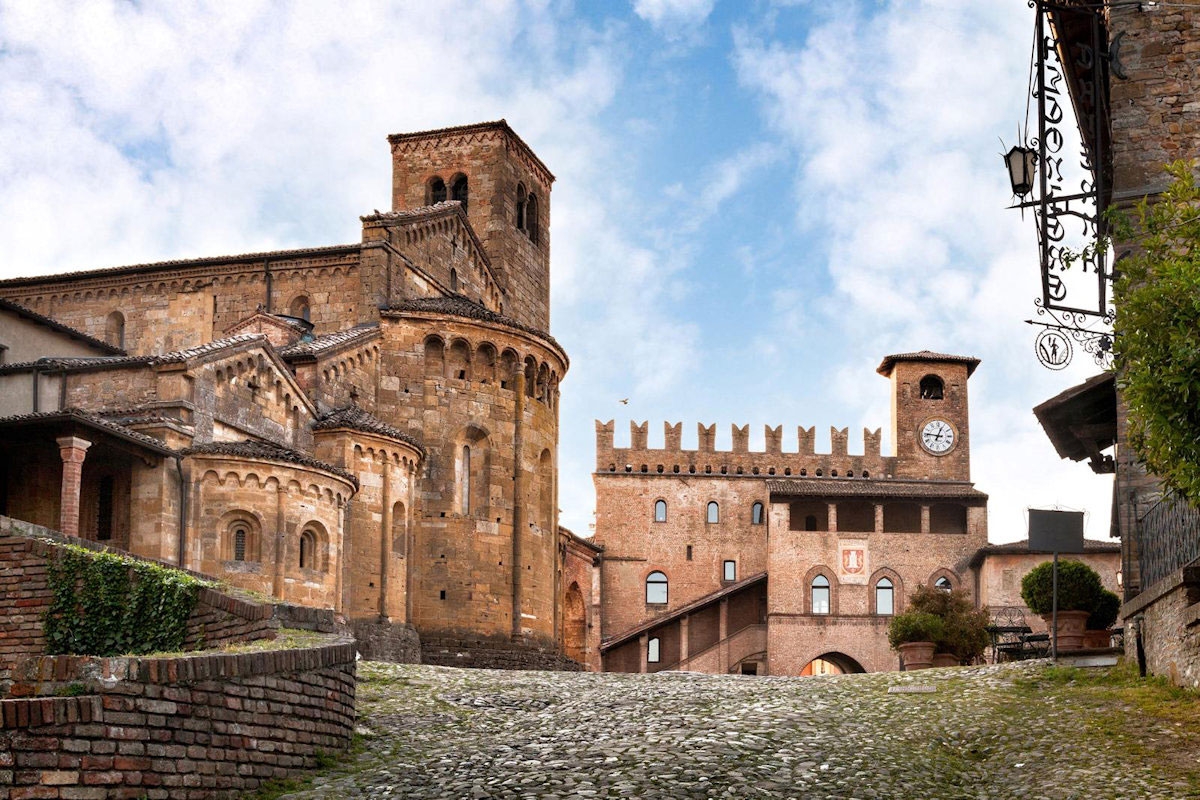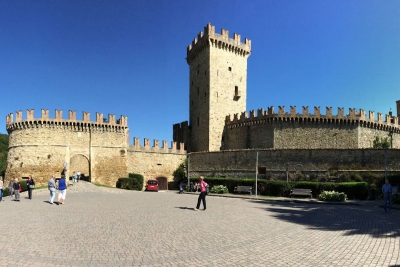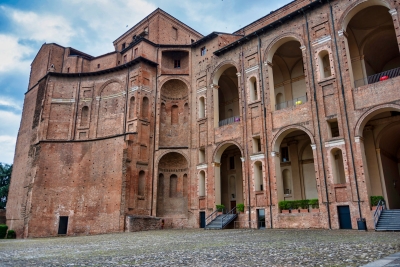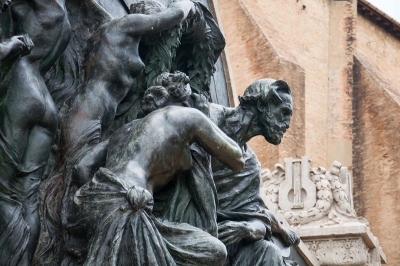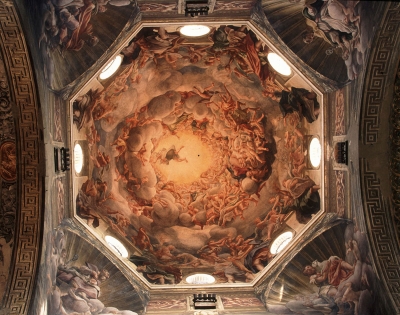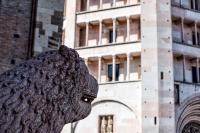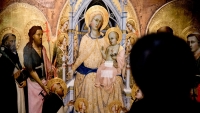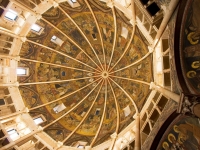The itinerary in the historic centre of Reggio Emilia winds its way through narrow streets, palaces and places of worship with magnificent architectures, such as the Sanctuary of the Beata Vergine della Ghiara, which houses a fresco considered miraculous depicting the "Madonna adoring the Child". A church that is a true example of Emilian artistic production of the time, containing works by Alessandro Tiarini, Orazio Talami and Guercino.
The walk then leads to Piazza Grande, now called Prampolini, overlooked by the Cathedral of Reggio Emilia, where you can admire sculptures by Bartolomeo Spani and Prospero Sogari, the Baptistery and the Town Hall, which houses the prestigious and famous Sala del Tricolore (Tricolour Hall), now used as the Town Council Chamber.
Particularly striking and historically important is the Basilica di San Prospero, dedicated to the patron saint of the city. Inside you can admire a splendid cycle of frescoes by Camillo Procaccini dating back to the late 17th century and wooden stalls by Cristoforo and Lorenzo da Lendinara.
A walk in the medieval village of Castell'Arquato will allow you to admire dreamlike views and authentic pearls of Medieval history, in an atmosphere suspended between past and present.
Walking through narrow streets and cobbled streets, you will cross the Torrione Farnesiano, the Palazzo del Duca, the former Hospital of Santo Spirito (now home to the Geological Museum), until you reach the scenic square overlooked by the three symbols of the city: the Collegiate Church , symbol of religious power, the Rocca Viscontea , symbol of military power, and the Palazzo del Podestà , symbol of political power.
In addition to the monuments and landscape of the Val D’Arda, the village offers excellent wine tastings , unexpected musical tributes and many opportunities for historical and thematic re-enactments.
It is also included in the Regional Park of Piacenzano , a protected area and rich in sedimentary rock outcrops with an age that varies between 3.5 and 1.8 million years ago.
Small but charming fortified village, built on a limestone and sandstone spur that guarantees it a privileged position in the hills, Vigoleno is dominated by the Castle that belonged to the Visconti and then to the Scotti of Piacenza, now a noble residence. There are also the Oratory of the Virgin of Grace and the ancient Pieve di San Giorgio, which can be visited in an enchanting, intimate and silent atmosphere.
Vigolo Marchese
A few kilometers away, the ancient Baptistery of Vigolo Marchese, which flanks the Romanesque church dating back to 1008 the only remnant of a lost monastery. The baptistery, dating back to prior to the church and probably built as a pagan temple in Roman times, is one of the oldest examples of a circular building.
One of the most riche and flourishing cities of the Middle Ages, as evidenced by the numerous palaces and churches in the historic center: the Palazzo Gotico in the famous Piazza Cavalli , the Cathedral and the church of Sant’Antonino. Piacenza was the first capital of the Duchy of Parma and Piacenza and later became the second city of the Farnese state. The colossal Palazzo Farnese designed by Vignola , now home to the Civic Museums, dates back to the second half of the 16th century, whose collections ranging from archeology to the Risorgimento deserve an in-depth visit .
Strolling through the small town center can take you along part of the ancient Farnese bastions and to visit the church of San Sisto, for which Raphael painted the famous Sistine Madonna (now in Dresden), which preserves the tomb of Margaret of Austria, the natural daughter of Charles V and mother of the leader Alessandro Farnese.
A journey through the heart of music under the sign of Verdi and Toscanini, discovering the unwavering connection of the city with opera, older than what you expect and deeply rooted. We will talk about arias and concertos, openings and upper balconies, enchanted batons and generous duchesses.
Musical Promenades can be arranged to pass through
- the Regio Theatre
- the Farnese Theatre
- the Opera Museum
- the birthplace of Arturo Toscanini
- the Conservatory of Music
"Egli attese alla maniera moderna tanto perfettamente, che in pochi anni dotato dalla natura et esercitato dall’arte divenne raro e maraviglioso artefice”.
Giorgio Vasari speaks of Antonio Allegri da Correggio in the “Lives of the Most Excellent Painters…” as a genius who reached the pinnacle of his art within a few years despite his young age. Vasari, an artist recognized by many as one of the greatest of the Renaissance, marks the beginning of his brilliant career as a critic. Do not miss this journey in the art of the 16th century in the steps of this Master of the School of Parma, with imposing personages and delicate faces, enigmatic works, stupendous views…
It will be possible to visit:
- the Chamber of Saint Paul
- the frescoes of Saint John the Evangelist
- the dome of the cathedral
- the works of the National Gallery
Do not forget the other great genius of the 16th century, Francesco Mazzola, called “Parmigianino”, who left us the enigmatic fresco of the great arch of the Steccata and “the Turkish Slave” of the National Gallery.
The 11th, 12th and 13th centuries have left ancient symbols in Parma, engraved in the stone and most fascinating architecture of the city. Among the most interesting places are the Cathedral of Saint Mary of the Assumption, the baptistery, the Diocesan Museum and the Church of Santa Croce in the Oltretorrente district. They make up a framework of figures, symbols and cultural reminders that tell a thousand-year-old history of spirituality.
If you have enjoyed learning about the basics of Parma and you still have a lot of desire and a little time to spend in the city and not in its province, you have a choice of several major attractions. Depending on your interests and curiosity, we will be able to concoct the dream program to spend an unforgettable day in the city centre.
The Chamber of Saint Paul:
between sacred and profane, the ceiling painted by Correggio is an illusory pictorial rebus that is still awaiting a final solution…
The Diocesan Museum:
provides the opportunity to see the original works of Benedetto Antelami and the traces of the past discovered in the basement of Piazza Duomo
Il Museo Archeologico:
with the remains of the Roman Bridge, it testifies to the city’s past, from the beginning of its foundation. Note the Tabula Alimentaria, of fundamental importance, found at Veleia in 1747.
The Palatina Library:
a treasure trove of 18th-century Parmesan knowledge and elegance, enriched with 19th-century rooms and extraordinary collections of illuminated manuscripts, prints and ancient volumes.
The National Gallery:
In addition to the Farnese Theatre, it houses the masterpieces of the territory, the works of Correggio and Parmigianino, the portraits of the Dukes and the “Scapigliata” of Leonardo da Vinci. The museum facility of one of the most important cultural hubs of Emilia-Romagna is very interesting.
The Glauco Lombardi Museum and the Regio Theatre:
the priceless heritage of the Duchess Marie-Louise of Austria, represented by objects of everyday life, furniture and art collections, is gathered at the Glauco Lombardi Museum. The Regio Theatre is the unmissable destination for opera lovers.
The Sepulchre of the Farnese and Bourbons
in the crypt of the Church of the Steccata: the tour of the crypt is part of the exhibition rout of the Constantinian Museum of the Church of the Steccata, which provides a glimpse of the city’s life, linked to the prestigious Constantinian Order of Saint Georges.
The Library of Saint John the Evangelist,
on the first floor of the monastic complex consisting of the cloisters, the grocery and the Saint John Church, gathers together ancient knowledge in a magnificent structure from the second half of the 16th century. A place of meditation and study, it retains a cycle of partially unpublished frescoes to be observed while savouring every detail.
Museums – the Stuard Pinacoteca:
Along a chronological route within the ancient walls of the Benedictine convent of Saint Paul there are exhibits of archaeology pieces, sculptures, paintings, drawings and many other works. The room dedicated to Amedeo Bocchi and the famous “Greyhound” of Parmigianino is remarkable.
The Opera Museum and the House of Sound
These museums testify to Parma’s deep connection with music: while the House of Music houses the Opera Museum, which covers the entire history of opera in Parma from the 17th to the 20th century, the House of Sound provides a curious itinerary through the technological inventions that have allowed reproduction of sound from the end of the 19th century to the present day.
The Oltretorrente,
a popular district rich with history: the Church of Santa Croce on the Via Francigena, the old hospital, the spectacular Annunciation Church.
The Palazzo del Giardino,
a jewel in the centre of the Ducal Park, presents a fabulous cycle of frescoes from the Farnesian period.
Recalling the city’s Roman origins, it was founded in 183 BC, like its neighbour Modena, and it remains above the route of the Via Emilia and the ancient forum that has today become the still very lively Piazza Garibaldi.
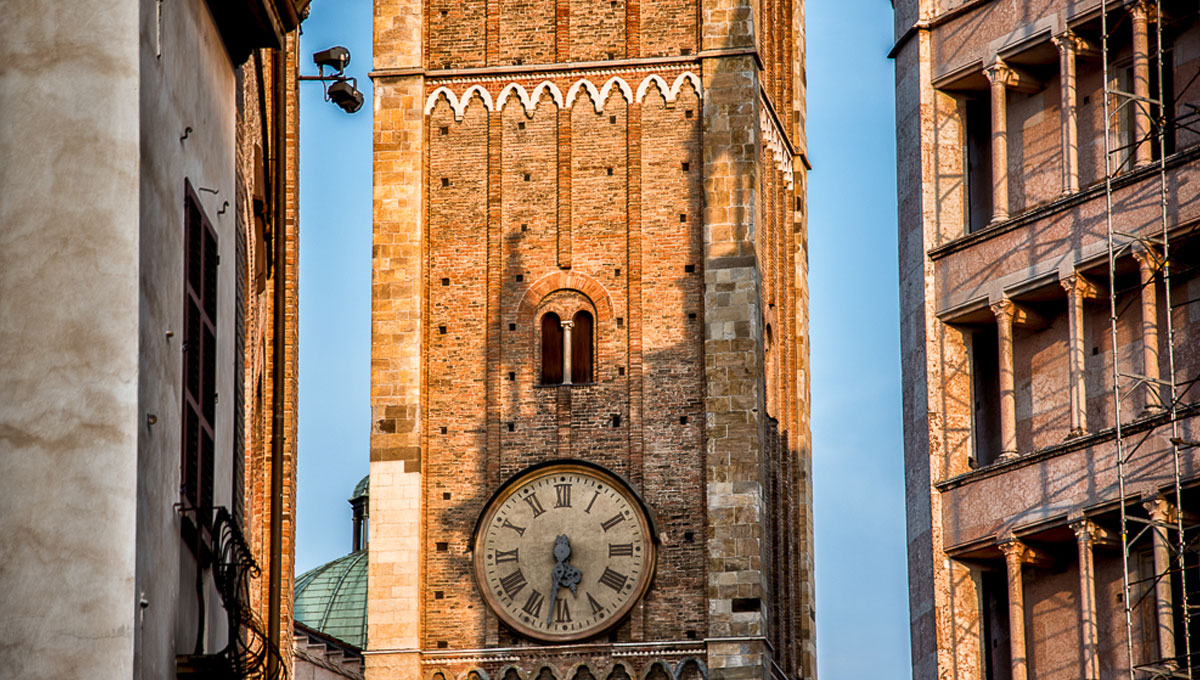
The most visible monumental footprint is that left by the Middle Ages, in particular on the magical Piazza Duomo. This square is one of the most beautiful and romantic places in Italy, framed by the bishopric, the Santa Maria Assunta Cathedral and the baptistery. These imposing works date from the 11th and 12th centuries and are marked by the seal of Benedetto Antelami, author of the baptistery. If you look up into the cupola of the Duomo, the gaze is lost in the thousand characters painted by Correggio, an indispensable figure in our Renaissance, whose works are also found in the neighbouring monastery of Saint John the Evangelist.
The cultural richness of the 16th century is illustrated in all its splendour at the Minor Basilica of Santa Maria della Steccata and in the complex of Saint John the Evangelist.
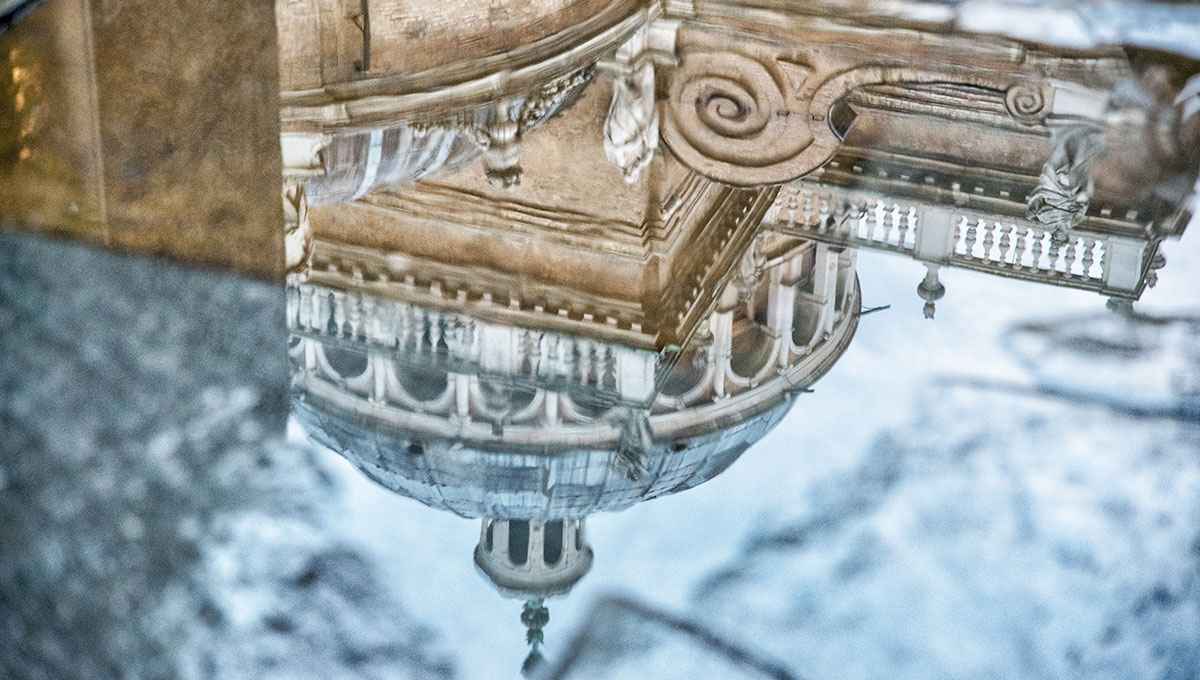
The second half of the century saw the birth, under the aegis of Pope Paul III Farnese, of the famous Duchy of Parma and Piacenza.
The itinerary connects the monumental complex of La Pilotta with the Ducal Park. The Farnese Theatre, built in 1618 by Ranuccio I, is a key step in the city’s tour.
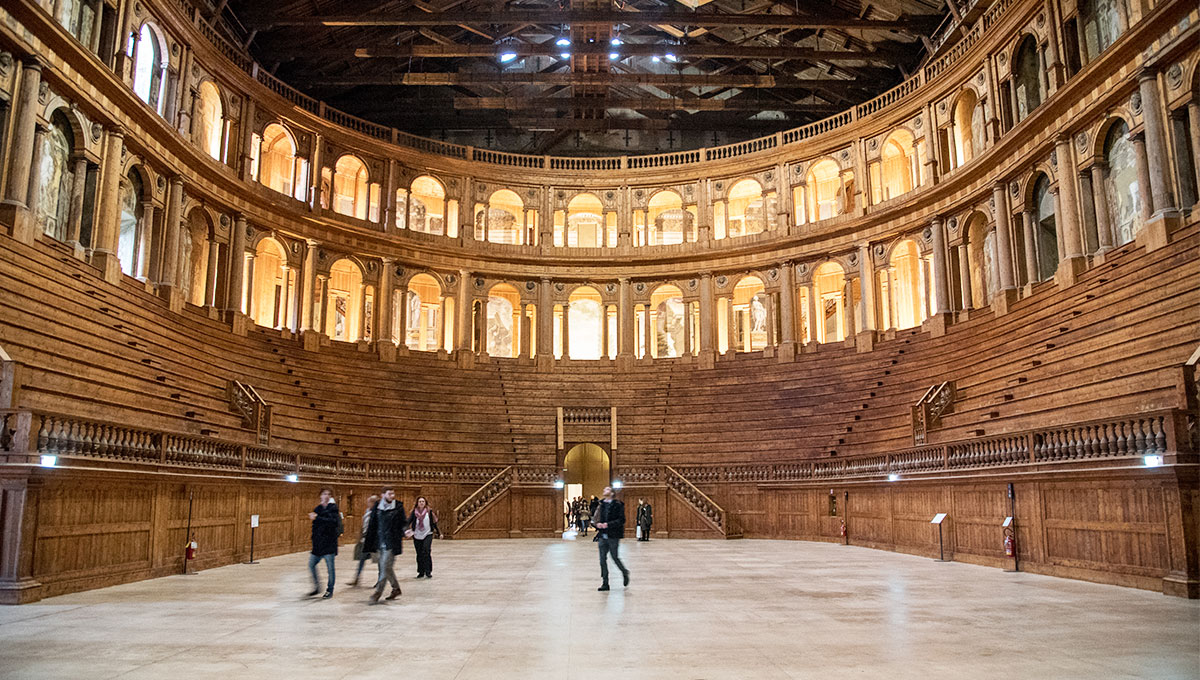
The arrival of the Bourbons in 1734 marked the European cultural turning point of the city. The following decades saw the birth of the Palatina Library and the Bodoni Printing House, while the city was covered with neo-classical buildings of French taste.
The international aura emerged with Philippe de Bourbon and his wife Louise Elisabeth, and grew up with the Duchess Marie-Louise of Austria who governed the city from 1816 to 1847, founded the Regio Theatre and left an unforgettable memory in the hearts of many Parmesans. It was at this time that the young Giuseppe Verdi asserted himself and that the talent of Arturo Toscanini flourished.
